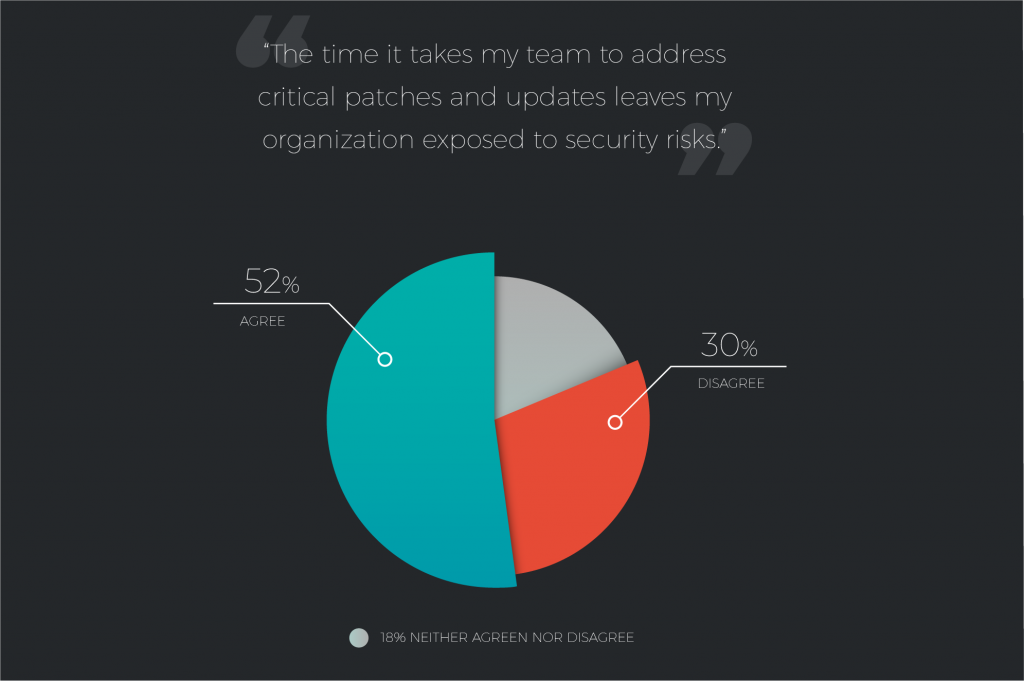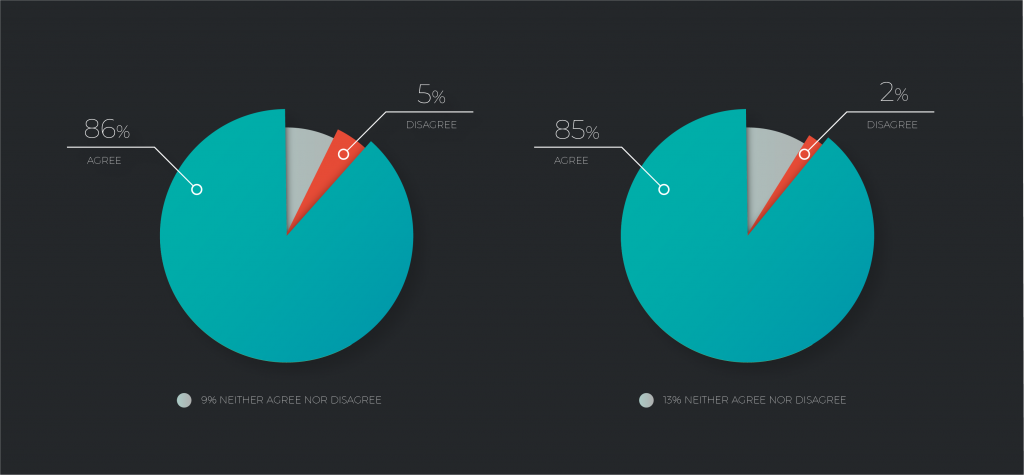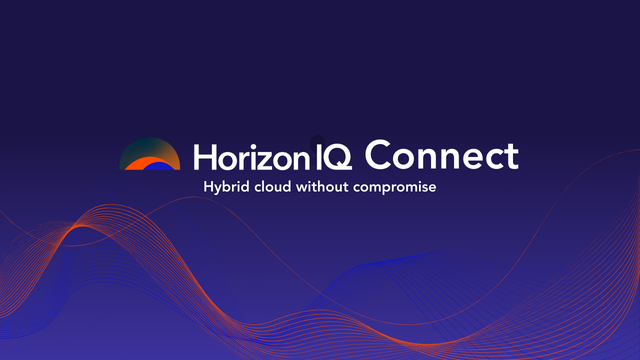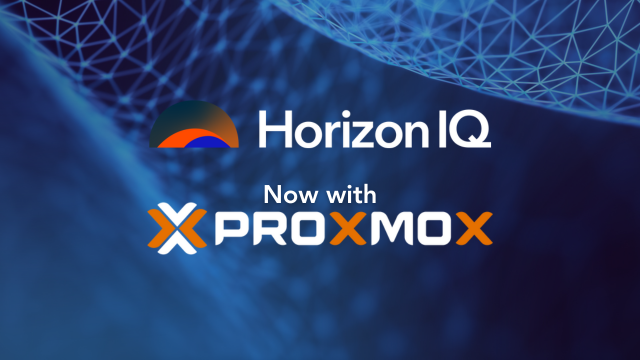Month: December 2018

In our latest survey, The State of IT Infrastructure Management, we asked 500 IT professionals to identify what they believe to be IT’s biggest infrastructure challenges for 2019. Here’s how they answered:
- Protecting the organization from cyberattacks
- Migrating applications to the cloud
- Adopting and/or managing a multicloud strategy
- Scaling infrastructure for business growth
- Budget or headcount constraints
- Automating routine processes to increase efficiency/free up internal resources
- Aligning more closely with goals of business units
- Adopting a disaster recovery or business continuity strategy
- Managing outsourcing partners/service providers
- Developing clear project priorities
- Skills shortages hindering key initiatives
- Obtaining quality feedback from end users and customers
Let’s dive a little deeper.
Security
Cybersecurity’s position at the top of the list is unsurprising, given the relentless frequency of high-profile security breaches. And from ransomware to malicious SQL code injections, cyberattacks have been and will continue to be a threat to organizations around the world in 2019.
The ever-expanding threat landscape is putting a major strain on IT professionals. For instance, a majority of survey respondents said that the time it takes their teams to address critical patches and updates leaves their organizations exposed to security risks. As enterprises increasingly move to multicloud IT deployments, maintaining a 360-degree security strategy will only grow more complex.
Cybersecurity may also explain why 1 in 6 IT pros chose “Adopting a disaster recovery or business continuity strategy.” One of IT’s fundamental responsibilities is to maintain operational uptime and high-availability. If a ransomware attack takes a production system down, IT teams must have a failover site in place.
We’ll be diving further into our findings around security in the coming weeks, so stay tuned to the ThinkIT blog.
Adopting a Cloud Strategy
Challenges of the cloud, whether migrating applications to the cloud or adopting and managing a multicloud strategy, follow closely behind security.
So where does one start? Gartner has their seminal “Five Rs” and AWS has six for conceptualizing cloud migration strategies. Whether you’re a fan of Gartner’s Rs or prefer AWS’s, these frameworks both illustrate an important point: Cloud migration requires evaluating between several options and committing to a thoughtful cloud strategy.
This process will look slightly different at each organization, but the first step is the same: determining the right cloud environment for your applications. Starting from the question of what’s best for your applications is the most effective way to ensure your cloud solution provides the best value to your organization.
Once that’s been decided, the process becomes about ensuring you have the right people and processes in place to get the most out of it, managing effective partners (No. 9 on the list), migrating your applications in a way that is minimally disruptive, and then establishing the proper tools to maintain visibility into your environments. This last task is more difficult in a multicloud world where environments are complex and often interconnected, but the challenge is worth it, especially to reap the benefits of scalability that the cloud affords, which brings us to the next top challenge.
Scalability
As businesses grow, workloads grow more intense, and applications must scale up. This makes cloud an “obvious” choice for many. After all, the ability to dynamically scale resources is one of the most commonly touted reasons for migrating to major public cloud providers, especially with the availability of pay-as-you-go options sweetening the pot.
While hyperscale cloud is a powerful option and often a great choice for many, it’s not the only way to access the scalability your organization needs as it grows, and there are other options that can mitigate some of the complexities of managing a multicloud environment.
Hosted private clouds have many of the same benefits as public cloud, with the additional benefit of being right-sized to your applications and resource needs from the start. Plus, it’s easy to spin up new compute and storage resources as your applications require them—with the help of your trusted IT service provider.
Another option is choosing to deploy in a high-density colocation facility, which allows IT organizations to work with their data center partners to make sure they have the capacity to grow within the space, in addition to being in total control of adding resources as needed. High power density environments mean you can harness the same power in a smaller footprint, unlocking even greater potential for growth.
Pivoting Toward Alignment
Budget or headcount restraints, skills shortages, the need to develop clear project priorities and obtain quality feedback from end users and customers: These challenges all speak to IT professionals who want to do more than “keep the lights on” to truly drive innovation and align with the rest of their companies’ business goals but feel hindered from doing so.
This dovetails with two key findings from our survey: 86 percent of respondents agreed with the statement, “My IT department is leading the organization’s digital transformation efforts.” A full 85 percent of IT professionals agreed with the statement, “For my IT department to succeed, we must be seen more as a center of innovation and less as an operational cost center.” [See figure below.]
In the face of being asked to do more with less budget, a lack of skilled staff or unclear priorities, IT is being pulled in two directions.
On one side is the constant need to merely maintain IT systems functionality, an often enormously time-intensive task, and one that still leads to IT professionals being interrupted six times a month on average during non-work hours, according to our survey. On the other is the need to innovate and be more than “just IT.”
This likely explains why 1 in 4 survey respondents say “automating routine processes to increase efficiency and free up internal resources” is a top challenge. Using new tech to offload upkeep is a logical reaction to the resource crunch that IT professionals are faced with.
IT professionals know what they should be doing to create value for the rest of the organization beyond routine IT maintenance and monitoring, and they’re hungry to do so. The challenge is how.
Explore HorizonIQ
Bare Metal
LEARN MORE
Stay Connected

Recap: Gartner IT Infrastructure, Operations & Cloud Strategies Conference 2018
Multicloud, hybrid infrastructure, the edge, disaster recovery, cloud misperceptions and more: Gartner’s annual IOCS conference wrapped up recently, and what an event it was—so many incredible conversations in one space over an entire week. I walked away with pages of notes and a myriad of thoughts on the topics covered. Here are some of the big ones.
The Cloudiness of “Cloud”
Ask any 10 people to define the “cloud” and you’d probably still get 10 different answers even after all these years, whether IaaS, SaaS, PaaS, private cloud, public cloud, and so on. But regardless of how you’d define it, the crystal-clear message from the event was that we are living in—and will continue to live in—a multicloud world.
Mindy Cancila, Managing Vice President at Gartner, explained that cloud is not one-size-fits-all and that the most sophisticated IT organizations determine their infrastructure delivery models based on the needs and objectives of their specific applications and workloads, for reasons related to both cost and performance.
She dove deep into one particularly hot cloud topic in her keynote session: “Is the Public Cloud Cheaper Than My Data Center?”
The answer? It depends.
While the general perception may be that public cloud is cheaper, the research suggests otherwise—or at least in many scenarios. By 2020, organizations that lack cost optimization process will average 40 percent overspend in the public cloud. This may be for some a scary projection, especially when you’re talking about organizations that are spending millions of dollars annually (or even monthly) in the public cloud.
It’s important to reiterate, however, that this is situational and that some use cases can actually yield savings. Either way, IT organizations must make wise decisions when it comes to application and workload placement.
Gartner’s Five “Rs” of Multicloud
Given the wave of cloud initiatives among IT organizations, Cancila also shared Gartner’s “5 ‘Rs’” framework to assist IT leaders in making multicloud decisions.
The most impactful visual from this presentation showed how each “R” mapped to a cloud value curve; depending on which “R” you’re planning to execute, there’s a spectrum of what value you derive from moving to a public cloud service.
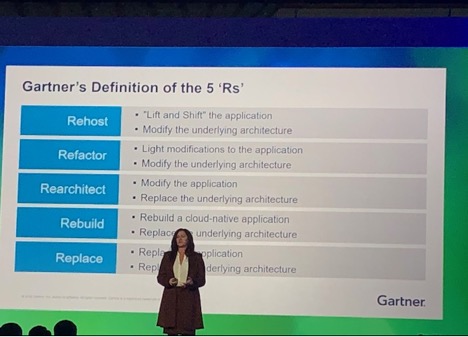
For example, if you’re simply rehosting an application—i.e., lifting and shifting—the value you will derive from a public cloud is limited or even potentially non-existent. If instead you plan to completely rebuild or replace your applications, the value derived from a public cloud service could be significant. This, yet again, highlights the need for multicloud strategy and skills in the IT organization.
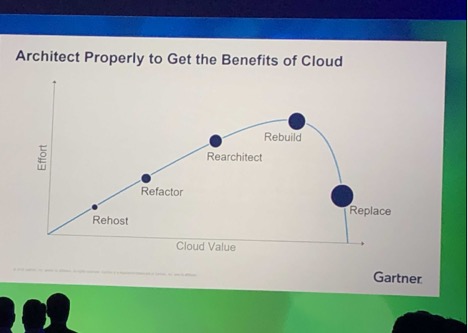
IT’s Top Challenges
Many of the sessions included live audience polling about a variety of hot-button topics. One was particularly close to my heart and persistently top-of-mind: the challenges that IT doers face in their efforts to balance the short and long terms (or in Gartner terms, Mode 1 and Mode 2 IT). N.B.: Audience sizes varied from 100 to 300+ in the individual sessions, so the sample size wasn’t bad.
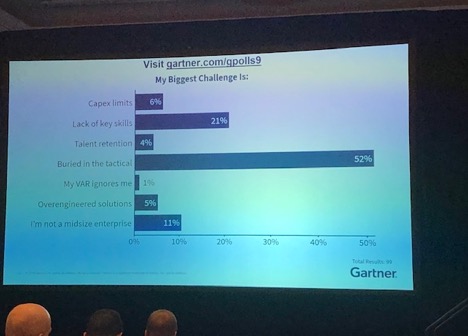
Not surprisingly, more than half the audience said that their biggest challenge was “buried in the tactical.” At HorizonIQ, we see this day in and day out, and it’s core to our belief that if we can give time back to IT teams by easing or removing the work of “keeping the lights on,” they will be freed to do more value-added and innovative work that better drives the mission and purpose of their organizations.
This supports findings from our new survey report, The State of IT Infrastructure Management: 77 percent of the IT professionals we surveyed agreed with the statement, “I could bring more value to my organization if I spent less time on routine tasks like server monitoring and maintenance.”
The second highest response was “lack of key skills.” Based on both the sessions and one-to-one conversations I was a part of, key skills mostly revolve around multivendor cloud management, hybrid infrastructure strategy and execution, and general public cloud know-how.
CIOs in the Middle
Since HorizonIQ serves mid-market enterprises very well, I was drawn to a session that was titled “How to Optimize IT Infrastructure for Midsize Enterprise Requirements.” The speaker unpacked a view of what CIOs in the mid-market face, given their size and all the advantages and disadvantages that come with that.
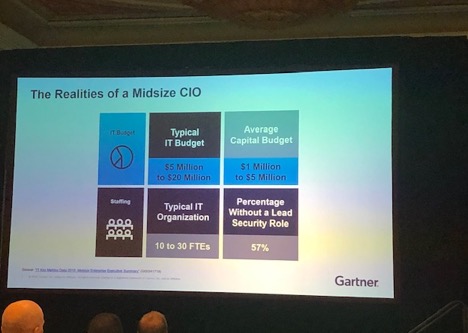
This quote stood out among the rest: “Midsize enterprises should not just be thought of as a smaller version of large enterprises.” At first, you tilt your head and wonder what that actually means, since logic would say that they are. But the point was that midsize enterprises operate quite differently, both favorably and unfavorably, depending on the project or decision to be made.
That being said, there is at least one commonality among CIOs regardless of organization size: They want—and need—a bigger seat at the table and should be seen as core to digital transformation and innovation.
Gettin’ Edgy
Two out of every three conversations seemed to include the words “edge” or “edge computing.” It’s certainly a hot topic among Gartner followers and the IT community at large. Distinguished VP Analyst Thomas Bittman took the stage to educate the crowd on how Gartner actually defines the “edge.”
In short, Bittman explained that the edge is the physical location where things and people connect with the networked digital world.
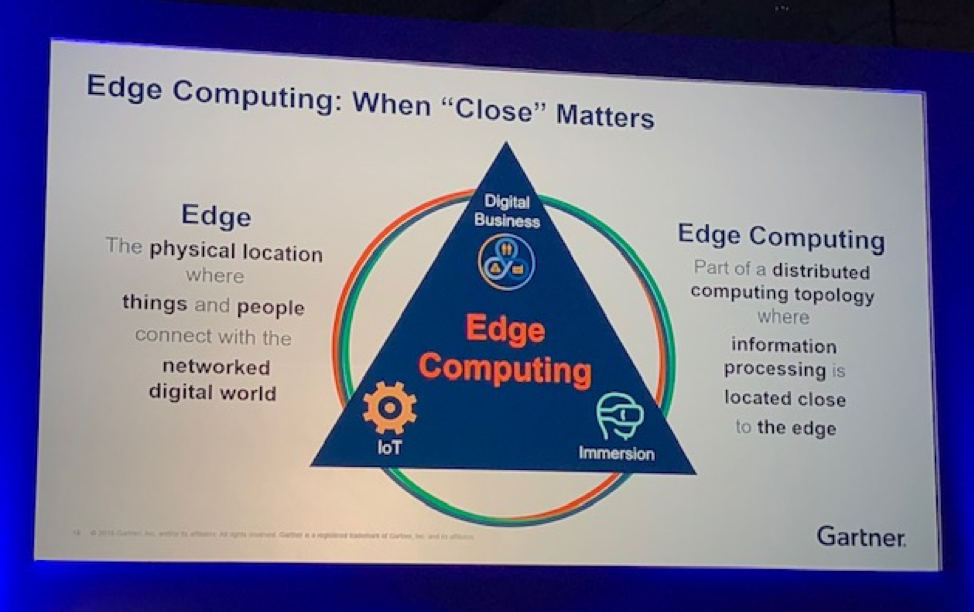
Edge computing, on the other hand, is “part of a distributed computing topology where information processing is located close to the edge.” This lines up quite well to a blog post I wrote on this very topic:
“The edge presents an exciting opportunity to explore just how close the technology can get us to the end user’s device, but high-performance applications need high-performance infrastructure from end to end.”
In other words, while the exciting stuff seems to be happening “at the edge,” none of that would be possible without a strong core of data centers and a low-latency network connecting everything.
Explore HorizonIQ
Bare Metal
LEARN MORE
Stay Connected

The drive for digital transformation has impacted virtually every business and industry across the globe. It can be easy to focus on the trends and movements that are taking place on the massive scale that the modern digital era has enabled—and there is certainly value in doing so.
Yet one critical piece of the story is often missing: what the changing IT landscape means for the professionals tasked with the day-to-day responsibilities of managing enterprise IT infrastructure—and in turn, what their perspective says about the future of IT.
What are they most concerned about? What are the big challenges they see facing global IT organizations, and which ones do they consider most pressing? What are their priorities? How do they spend their time at work, and perhaps more telling, how do they wish they spent their time?
In short: What is the state of enterprise IT infrastructure, and what insights can we glean from the perspectives of the IT professionals responsible for its management and operation?
In an effort to tackle some of these big questions, we conducted a new survey of 500 IT professionals, asking them about a variety of subjects, ranging from their IT infrastructure environments and day-to-day responsibilities to resource allocation strategy and how they feel IT is perceived.
The Big Takeaways
The survey produced a snapshot of the IT function in flux, as environments are migrated off-premise and IT professionals (not just executives) are eager for greater strategic responsibility and adjusting to shifting expectations—all on top of day-to-day responsibilities.

Multicloud and Hybrid IT Have Arrived
The vast majority of organizations with on-premise infrastructure already have workloads in colocation or cloud environments (89 percent), with a majority planning to move at least some infrastructure off-prem within the next three years.
Cybersecurity and Cloud Migrations Are Top Challenges
More than 1 in 3 respondents (36 percent) identified protecting their organization from cyberattacks as their No. 1 concern for 2019. No surprise, considering respondents estimated that 1 in 4 of their organization’s servers or cloud instances are behind on security patches, largely due to the time it takes to keep up with the ever-evolving threat landscape. Following security, other top challenges included migrating applications to the cloud (34 percent) and adopting/managing a multicloud strategy (28 percent).
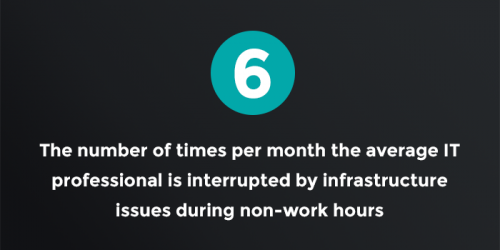
Time Isn’t Always IT’s Friend
8 in 10 IT pros (82 percent) cite at least one server- or cloud-related activity they spend too much time on. Similarly, 77 percent say there is at least one task they don’t spend enough time on. By and large, the data suggests that IT pros dedicate too many hours to monitoring and maintenance and not enough to designing or implementing new solutions.
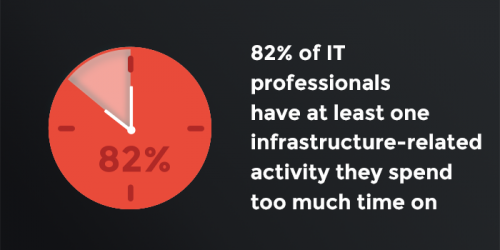
There’s More to Come
To read about these insights and more, download the report below—and keep an eye on our ThinkIT blog over the next few weeks: We’ll be diving deep into each of these topics and more.
Explore HorizonIQ
Bare Metal
LEARN MORE
Stay Connected
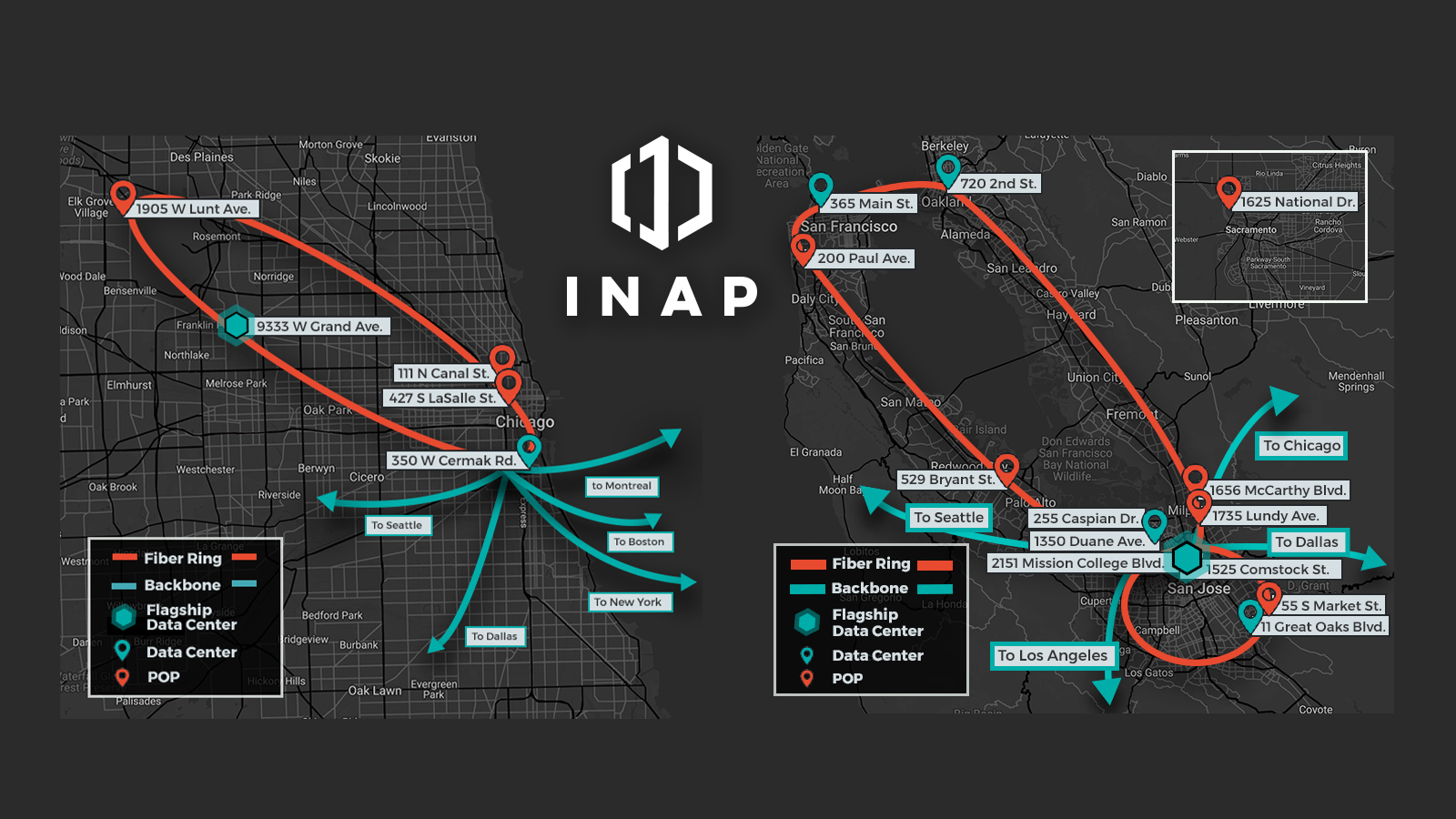
The Enhanced Global HorizonIQ Network Is Here
A complex, multi-site IT data center strategy is only as good as the network that weaves it together.
While the hype surrounding digital transformation and edge computing is very much justified, the fact remains that such initiatives can’t get off the ground without reliable connectivity, capacity to scale and low-latency transport. Absent these pillars of a strong network, end users and customers will be stranded on islands—forced to deal with more downtime and slower service.
That’s why access to high-performance network services is among the primary reasons organizations are shifting workloads away from on-premise data centers in increasingly large numbers.
This week, HorizonIQ solidified itself as a premium destination for enterprises in search of a high-performance network. With the completion of the first phase of our Global Network Transformation Initiative, we now offer direct connections via our high-capacity backbone between more than 100 data centers and POPs in strategically located global markets.
With an enhanced suite of connectivity products, along with our patented Performance IP technology, HorizonIQ is setting itself apart from other colocation and cloud service providers.
Introducing Connectivity Solutions
HorizonIQ Connectivity Solutions provide high availability and scalable connectivity services across our global network. This suite of solutions allows you to interconnect across our on-net sites, even if those data centers are not operated by INAP. This gives you the flexibility to be where you need to be, without having to consult with multiple network vendors or partners to interconnect sites.
HorizonIQ is among the only data center and cloud solution providers to offer this degree of connectivity across a self-maintained, highly scalable global network.
Metro Connect
Metro Connect allows you to connect to multiple HorizonIQ data centers and POPs within a metro area. Our dark fiber rings provide multiple points of egress for your traffic and help you avoid single points of failure for service within a market.
This product was made possible by our Phase 1 redesign of six major metropolitan market rings. The improvements bolster capacity, increase connectivity to more sites, and enhance protected services for HorizonIQ customers. You can explore the new rings below and learn more about each market at our data centers page.
Network Connect
Network Connect provides a link between any HorizonIQ Data Center and network POP across our high-capacity backbone. Choose between 21 strategically located markets spread across the globe. Whether you need to connect your Dallas and London offices, reach a new audience in central Europe from the Bay Area, or connect many locations in between—we can take you there via the most efficient, high-performing path.
Low Latency & High Availability With Performance IP
Performance IP is our not-so-secret weapon, and it’s built into each of our data centers, POPs, and hosted products. The service includes a blend of Tier 1 ISPs at each on-net location and is enhanced by our one-of-kind automated route optimization. This intelligent automation probes network performance in real-time, always putting your outbound traffic on the best-performing, lowest-latency route.
This is just the beginning of our network transformation. Supported by Performance IP, our global network is continuing to expand, empowering our customers to grow with us. With Phase 2 already underway, we’ll soon be expanding connectivity to additional markets and launching several new cutting-edge network products.
For now, connect with HorizonIQ, and stay tuned for more.

